Search Result
Results for "
Gum guaiac
" in MedChemExpress (MCE) Product Catalog:
7
Biochemical Assay Reagents
4
Isotope-Labeled Compounds
| Cat. No. |
Product Name |
Target |
Research Areas |
Chemical Structure |
-
- HY-N6664
-
|
Arabic Gum
|
Others
|
Others
|
|
Gum Arabic (Arabic gum) is a branched-chain, complex polysaccharide derive from A. Senegal. Gum Arabic is an anti-oxidant, and can protect against experimental hepatic-, renal- and cardiac toxicities. Gum Arabic also can be used in immunohistochemistry .
|
-

-
- HY-W145515
-
|
Indian Gum
|
Biochemical Assay Reagents
|
Others
|
|
Gum ghatti is a biochemical reagent that can be used as a biological material or organic compound for life science related research.
|
-

-
- HY-125870
-
|
|
Biochemical Assay Reagents
|
Inflammation/Immunology
|
|
Gellan gum is a linear microbial exopolysaccharide that can be used as a cell scaffold for both soft tissue and load bearing applications. Gellan gum has many advantages such as biocompatibility, biodegradability, nontoxic in nature, and physical stability in the presence of cations .
|
-

-
- HY-W145517
-
|
|
Biochemical Assay Reagents
|
Others
|
|
Karaya gum is a biochemical reagent that can be used as a biological material or organic compound for life science related research.
|
-

-
- HY-W250121
-
|
|
Biochemical Assay Reagents
|
Others
|
|
Tragacanth gum is a biochemical reagent that can be used as a biological material or organic compound for life science related research.
|
-

-
- HY-W145516
-
|
|
Biochemical Assay Reagents
|
Others
|
|
Guar gum is a versatile polymer for drug delivery applications. Guar gum diaplays thickening, emulsifying, binding and gelling properties, quick solubility in cold water, wide pH stability, film forming ability and biodegradability, it finds applications in large number of industries. Guar gum can be isolated from the powdered endosperm of the seeds of the Cyamopsis tetragonolobus. Guar gum can be used as an excipient, such as thickener, suspending agent. Pharmaceutical excipients, or pharmaceutical auxiliaries, refer to other chemical substances used in the pharmaceutical process other than pharmaceutical ingredients. Pharmaceutical excipients generally refer to inactive ingredients in pharmaceutical preparations, which can improve the stability, solubility and processability of pharmaceutical preparations. Pharmaceutical excipients also affect the absorption, distribution, metabolism, and elimination (ADME) processes of co-administered drugs .
|
-

-
- HY-A0103
-
|
|
|
|
|
Xanthan gum is a microbial polysaccharide produced by Xanthomonas campestris. The structure of xanthan gum is based on a cellulose backbone of β-(1-4)-linked glucose units with a trisaccharide side of mannose-glucuronic acid-mannose attached to every other glucose unit in the backbone chain. Some terminal mannose units are pyruvated and some internal mannose units are acetylated. Due to its unique rheology and gelling properties, it is widely used as a food additive, thickener and stabilizer in the food and petroleum industries.
|
-

-
- HY-W145661
-
|
Styrax resinoid
|
Biochemical Assay Reagents
|
Others
|
|
Gum storax (Styrax balsam) is a biochemical reagent that can be used as a biological material or organic compound for life science related research.
|
-

-
- HY-W250146
-
|
|
Biochemical Assay Reagents
|
Others
|
|
Locust bean gum is a natural polysaccharide derived from the seeds of the carob tree. It is commonly used as a thickening, stabilizing and gelling agent in a variety of foods, including dairy, baked goods and meat products. Locust bean gum has several properties suitable for these applications, including high water retention capacity, ability to form stable gels at low temperatures, and resistance to acidic conditions. Additionally, it can be used as a dietary fiber supplement due to its potential health benefits, including improving digestion and lowering cholesterol levels.
|
-
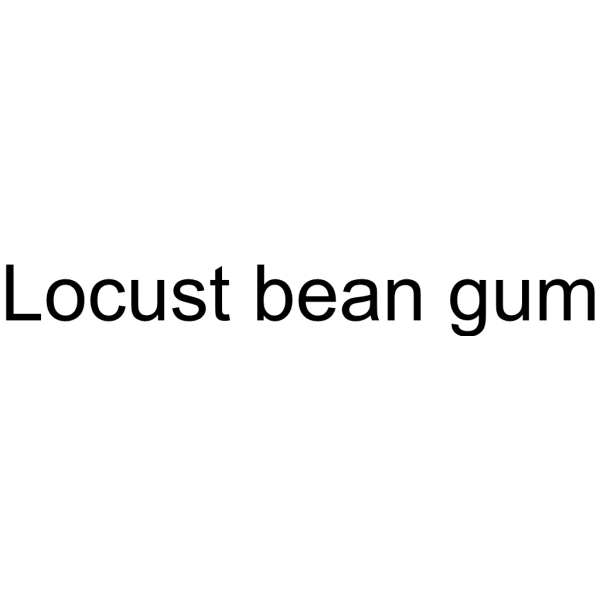
-
- HY-N3980
-
|
Champacol; guaiac alcohol
|
Autophagy
|
Infection
Cancer
|
|
Guaiol is a sesquiterpene alcohol that has been found in several traditional Chinese medicinal plants and has antiproliferative, pro-autophagic, insect repellent, and insecticidal biological activities .
|
-
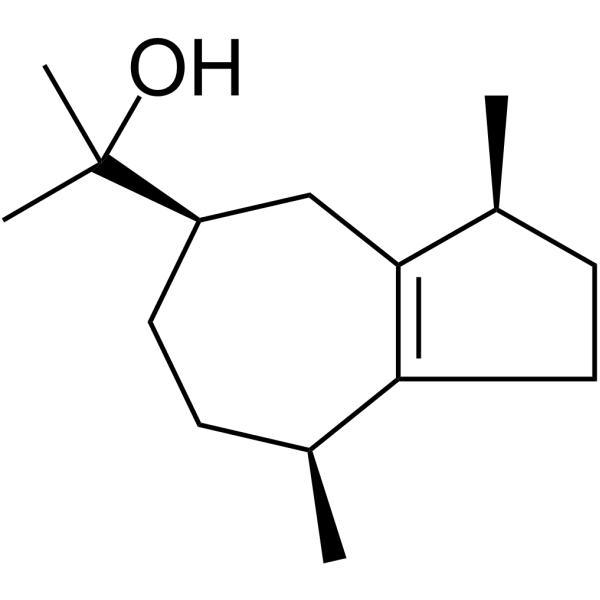
-
- HY-N2075
-
-
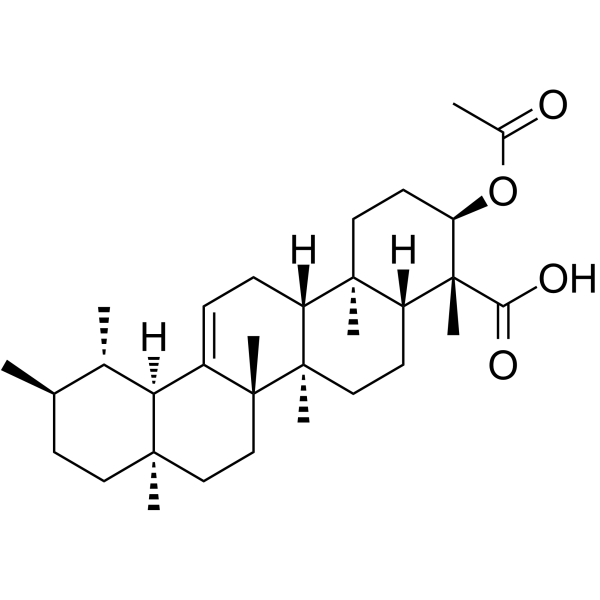
-
- HY-B0264
-
|
guaiacol glyceryl ether; Guaiphenesin; Glycerol guaiacolate
|
Mucin
|
Neurological Disease
Inflammation/Immunology
|
|
Guaifenesin (Guaiacol glyceryl ether), a constituent of guaiac resin from the wood of Guajacum officinale Linné, is an expectorant. Guaifenesin can alleviate cough discomfortby increasing sputum volume and decreasing its viscosity, thereby promoting effective cough .
|
-

-
- HY-B0264S
-
|
guaiacol glyceryl ether-d3; Guaiphenesin-d3; Glycerol guaiacolate-d3
|
Isotope-Labeled Compounds
|
Neurological Disease
Inflammation/Immunology
|
|
Guaifenesin-d3 is the deuterium labeled Guaifenesin. Guaifenesin (Guaiacol glyceryl ether), a constituent of guaiac resin from the wood of Guajacum officinale Linné, is an expectorant. Guaifenesin can alleviate cough discomfortby increasing sputum volume and decreasing its viscosity, thereby promoting effective cough[1][2].
|
-
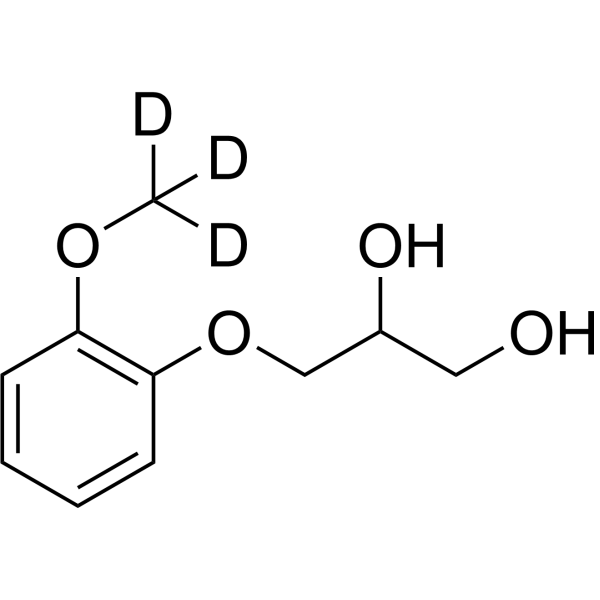
-
- HY-B0264R
-
|
guaiacol glyceryl ether(Standard); Guaiphenesin(Standard); Glycerol guaiacolate (Standard)
|
Others
|
Neurological Disease
Inflammation/Immunology
|
|
Guaifenesin (Standard) is the analytical standard of Guaifenesin. This product is intended for research and analytical applications. Guaifenesin (Guaiacol glyceryl ether), a constituent of guaiac resin from the wood of Guajacum officinale Linné, is an expectorant. Guaifenesin can alleviate cough discomfortby increasing sputum volume and decreasing its viscosity, thereby promoting effective cough .
|
-
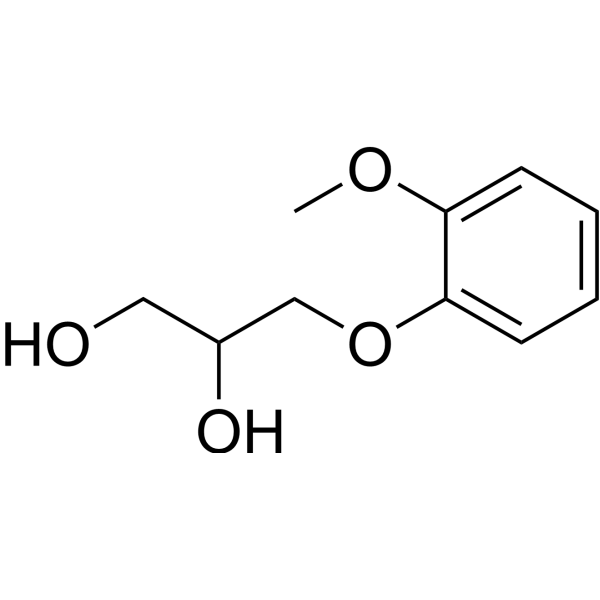
-
- HY-B0264S1
-
|
|
Isotope-Labeled Compounds
|
Neurological Disease
Inflammation/Immunology
|
|
Guaifenesin-d5 is the deuterium labeled Guaifenesin. Guaifenesin (Guaiacol glyceryl ether), a constituent of guaiac resin from the wood of Guajacum officinale Linné, is an expectorant. Guaifenesin can alleviate cough discomfortby increasing sputum volume and decreasing its viscosity, thereby promoting effective cough. Guaifenesin also has narcotic effect[1][2].
|
-
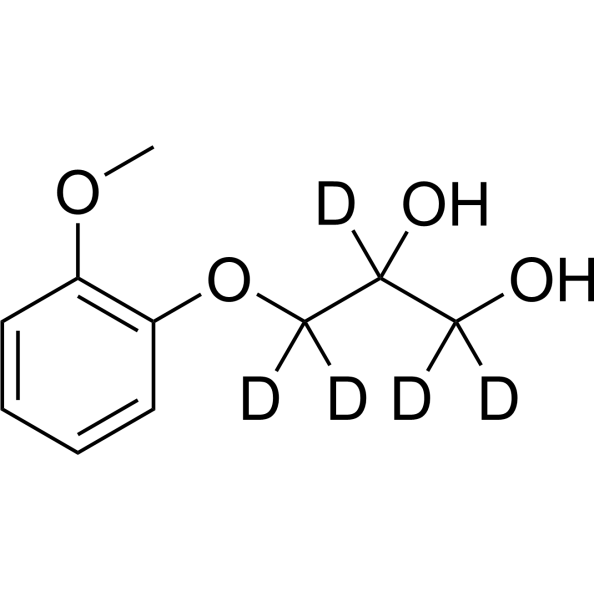
-
- HY-42680S
-
|
D-(-)-Tagatose-13C
|
Isotope-Labeled Compounds
Endogenous Metabolite
|
Metabolic Disease
Cancer
|
|
D-Tagatose- 13C is the 13C labeled D-Tagatose. D-Tagatose (D-(-)-Tagatose) is a rare monosaccharide found in nature with prebiotic characteristics. D-Tagatose is as a substitute for sucrose and a low-calorie sweetener in foodstuffs such as gum, fruit juice
|
-
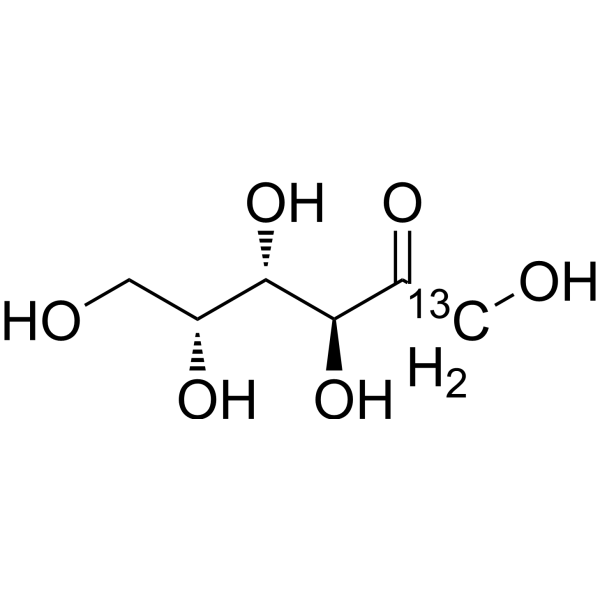
-
- HY-N6612
-
|
|
Endogenous Metabolite
|
Metabolic Disease
Inflammation/Immunology
|
|
D-Glucuronic acid is an important intermediate isolated from many gums, which has an anti-inflammatory effect for the skin. D-Glucuronic acid and its derivative glucuronolactone are as a liver antidote in the prophylaxis of human health, and its derivatives have antitumor activity .
|
-
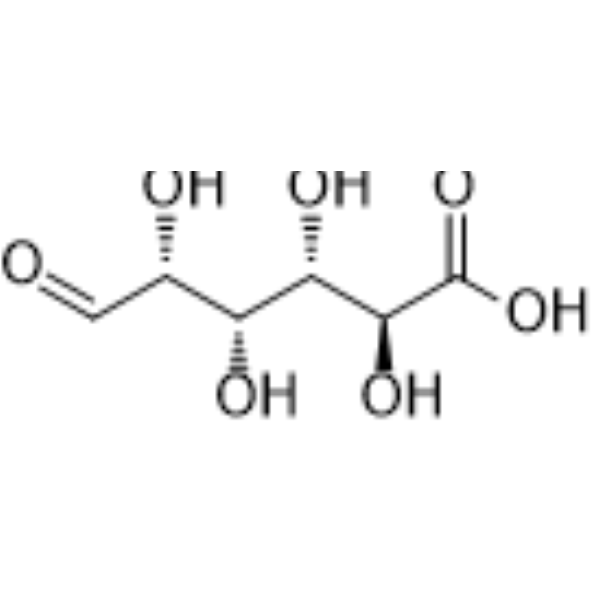
-
- HY-42680S1
-
|
D-(-)-Tagatose-13C-1
|
Isotope-Labeled Compounds
Endogenous Metabolite
|
Metabolic Disease
Cancer
|
|
D-Tagatose- 13C-1 is the 13C labeled D-Tagatose. D-Tagatose (D-(-)-Tagatose) is a rare monosaccharide found in nature with prebiotic characteristics. D-Tagatose is as a substitute for sucrose and a low-calorie sweetener in foodstuffs such as gum, fruit jui
|
-
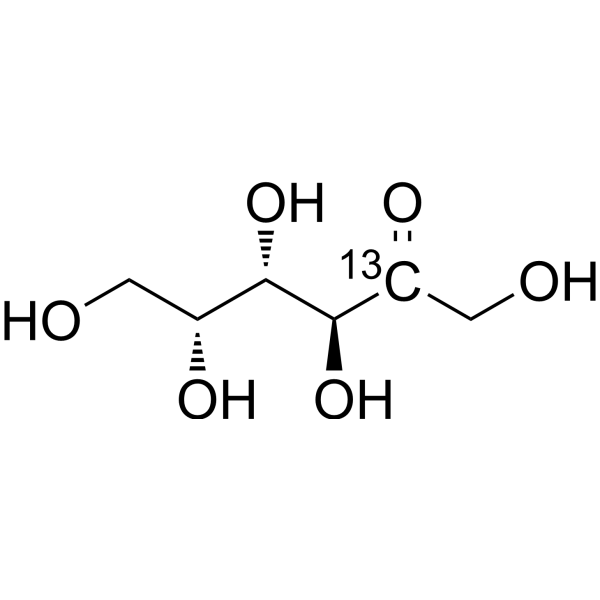
-
- HY-N8446
-
|
6,10-Dimethylundeca-5,9-dien-2-one; Dihydropseudoionone
|
Biochemical Assay Reagents
|
Others
|
|
(E/Z)-Geranylacetone is an organic compound commonly used as an ingredient in fragrances and fragrances. It can be used in some products such as perfumes, soaps and cosmetics, and can bring a fresh aromatic smell. In addition, the compound is used in some foods and pharmaceuticals, for example in candy, chewing gum and herbal remedies.
|
-

-
- HY-42680
-
|
D-(-)-Tagatose
|
Endogenous Metabolite
|
Metabolic Disease
Cancer
|
|
D-Tagatose (D-(-)-Tagatose) is a rare monosaccharide found in nature with prebiotic characteristics. D-Tagatose is as a substitute for sucrose and a low-calorie sweetener in foodstuffs such as gum, fruit juice, and beverages. D-Tagatose is also a potential antidiabetic agent for the research of type II diabetes and a prebiotic to help elevate beneficial bacteria in the colon, prevent colon cancer, and lower cholesterol .
|
-

-
- HY-N2513
-
|
|
Lipoxygenase
DNA/RNA Synthesis
|
Cancer
|
|
β-Boswellic acid is isolated from the gum resin of Boswellia serrata.
β-Boswellic acid is a nonreducing-type inhibitor of the 5-lipoxygenase (5-LO) product formation either interacting directly with the 5-LO or blocking its translocation . β-Boswellic acid inhibits the synthesis of DNA, RNA and protein in human leukemia HL-60 cells .
|
-

-
- HY-N2513R
-
|
|
Lipoxygenase
DNA/RNA Synthesis
|
Cancer
|
|
β-Boswellic acid (Standard) is the analytical standard of β-Boswellic acid. This product is intended for research and analytical applications. β-Boswellic acid is isolated from the gum resin of Boswellia serrata. β-Boswellic acid is a nonreducing-type inhibitor of the 5-lipoxygenase (5-LO) product formation either interacting directly with the 5-LO or blocking its translocation . β-Boswellic acid inhibits the synthesis of DNA, RNA and protein in human leukemia HL-60 cells .
|
-
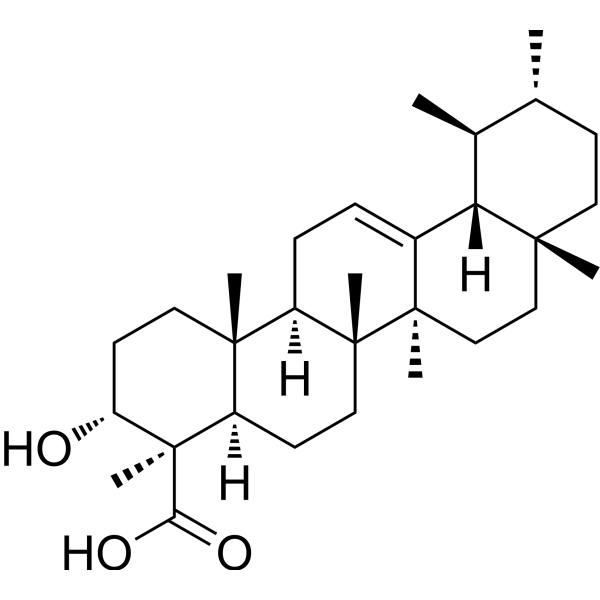
-
- HY-107738
-
Guggulsterone
Maximum Cited Publications
9 Publications Verification
Z/E-Guggulsterone
|
Apoptosis
JNK
Akt
Caspase
FXR
Autophagy
|
Cancer
|
|
Guggulsterone is a plant sterol derived from the gum resin of the tree Commiphora wightii. Guggulsterone inhibits the growth of a wide variety of tumor cells and induces apoptosis through down regulation of antiapoptotic gene products (IAP1, xIAP, Bfl-1/A1, Bcl-2, cFLIP and survivin), modulation of cell cycle proteins (cyclin D1 and c-Myc), activation of caspases and JNK, inhibition of Akt . Guggulsterone, a farnesoid X receptor (FXR) antagonist, decreases CDCA-induced FXR activation with IC50s of 17 and 15 μM for Z- and E-Guggulsterone, respectively .
|
-

| Cat. No. |
Product Name |
Type |
-
- HY-W145515
-
|
Indian Gum
|
Biochemical Assay Reagents
|
|
Gum ghatti is a biochemical reagent that can be used as a biological material or organic compound for life science related research.
|
-
- HY-125870
-
|
|
Biochemical Assay Reagents
|
|
Gellan gum is a linear microbial exopolysaccharide that can be used as a cell scaffold for both soft tissue and load bearing applications. Gellan gum has many advantages such as biocompatibility, biodegradability, nontoxic in nature, and physical stability in the presence of cations .
|
-
- HY-W145517
-
|
|
Biochemical Assay Reagents
|
|
Karaya gum is a biochemical reagent that can be used as a biological material or organic compound for life science related research.
|
-
- HY-W250121
-
|
|
Biochemical Assay Reagents
|
|
Tragacanth gum is a biochemical reagent that can be used as a biological material or organic compound for life science related research.
|
-
- HY-W145661
-
|
Styrax resinoid
|
Biochemical Assay Reagents
|
|
Gum storax (Styrax balsam) is a biochemical reagent that can be used as a biological material or organic compound for life science related research.
|
-
- HY-W250146
-
|
|
Biochemical Assay Reagents
|
|
Locust bean gum is a natural polysaccharide derived from the seeds of the carob tree. It is commonly used as a thickening, stabilizing and gelling agent in a variety of foods, including dairy, baked goods and meat products. Locust bean gum has several properties suitable for these applications, including high water retention capacity, ability to form stable gels at low temperatures, and resistance to acidic conditions. Additionally, it can be used as a dietary fiber supplement due to its potential health benefits, including improving digestion and lowering cholesterol levels.
|
-
- HY-N8446
-
|
6,10-Dimethylundeca-5,9-dien-2-one; Dihydropseudoionone
|
Biochemical Assay Reagents
|
|
(E/Z)-Geranylacetone is an organic compound commonly used as an ingredient in fragrances and fragrances. It can be used in some products such as perfumes, soaps and cosmetics, and can bring a fresh aromatic smell. In addition, the compound is used in some foods and pharmaceuticals, for example in candy, chewing gum and herbal remedies.
|
| Cat. No. |
Product Name |
Category |
Target |
Chemical Structure |
-
- HY-N6664
-
-

-
- HY-N3980
-
-

-
- HY-N2075
-
-

-
- HY-B0264
-
-

-
- HY-W145516
-
|
|
Structural Classification
Natural Products
Leguminosae
Source classification
Cyamopsis tetragonoloba (L.) Taub.
Plants
|
Biochemical Assay Reagents
|
|
Guar gum is a versatile polymer for drug delivery applications. Guar gum diaplays thickening, emulsifying, binding and gelling properties, quick solubility in cold water, wide pH stability, film forming ability and biodegradability, it finds applications in large number of industries. Guar gum can be isolated from the powdered endosperm of the seeds of the Cyamopsis tetragonolobus. Guar gum can be used as an excipient, such as thickener, suspending agent. Pharmaceutical excipients, or pharmaceutical auxiliaries, refer to other chemical substances used in the pharmaceutical process other than pharmaceutical ingredients. Pharmaceutical excipients generally refer to inactive ingredients in pharmaceutical preparations, which can improve the stability, solubility and processability of pharmaceutical preparations. Pharmaceutical excipients also affect the absorption, distribution, metabolism, and elimination (ADME) processes of co-administered drugs .
|
-

-
- HY-B0264R
-
-

-
- HY-N6612
-
-

-
- HY-42680
-
-

-
- HY-N2513
-
-

-
- HY-N2513R
-
-

-
- HY-107738
-
Guggulsterone
Maximum Cited Publications
9 Publications Verification
Z/E-Guggulsterone
|
Triterpenes
Structural Classification
Classification of Application Fields
Terpenoids
Plants
Burseraceae
Disease Research Fields
Commiphora wightii
Cancer
|
Apoptosis
JNK
Akt
Caspase
FXR
Autophagy
|
|
Guggulsterone is a plant sterol derived from the gum resin of the tree Commiphora wightii. Guggulsterone inhibits the growth of a wide variety of tumor cells and induces apoptosis through down regulation of antiapoptotic gene products (IAP1, xIAP, Bfl-1/A1, Bcl-2, cFLIP and survivin), modulation of cell cycle proteins (cyclin D1 and c-Myc), activation of caspases and JNK, inhibition of Akt . Guggulsterone, a farnesoid X receptor (FXR) antagonist, decreases CDCA-induced FXR activation with IC50s of 17 and 15 μM for Z- and E-Guggulsterone, respectively .
|
-

| Cat. No. |
Product Name |
Chemical Structure |
-
- HY-B0264S
-
|
|
|
Guaifenesin-d3 is the deuterium labeled Guaifenesin. Guaifenesin (Guaiacol glyceryl ether), a constituent of guaiac resin from the wood of Guajacum officinale Linné, is an expectorant. Guaifenesin can alleviate cough discomfortby increasing sputum volume and decreasing its viscosity, thereby promoting effective cough[1][2].
|
-

-
- HY-B0264S1
-
|
|
|
Guaifenesin-d5 is the deuterium labeled Guaifenesin. Guaifenesin (Guaiacol glyceryl ether), a constituent of guaiac resin from the wood of Guajacum officinale Linné, is an expectorant. Guaifenesin can alleviate cough discomfortby increasing sputum volume and decreasing its viscosity, thereby promoting effective cough. Guaifenesin also has narcotic effect[1][2].
|
-

-
- HY-42680S
-
|
|
|
D-Tagatose- 13C is the 13C labeled D-Tagatose. D-Tagatose (D-(-)-Tagatose) is a rare monosaccharide found in nature with prebiotic characteristics. D-Tagatose is as a substitute for sucrose and a low-calorie sweetener in foodstuffs such as gum, fruit juice
|
-

-
- HY-42680S1
-
|
|
|
D-Tagatose- 13C-1 is the 13C labeled D-Tagatose. D-Tagatose (D-(-)-Tagatose) is a rare monosaccharide found in nature with prebiotic characteristics. D-Tagatose is as a substitute for sucrose and a low-calorie sweetener in foodstuffs such as gum, fruit jui
|
-

Your information is safe with us. * Required Fields.
Inquiry Information
- Product Name:
- Cat. No.:
- Quantity:
- MCE Japan Authorized Agent:































